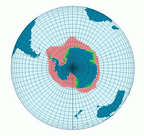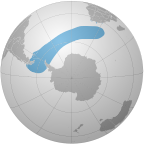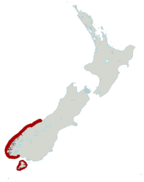List of penguins

Penguins are birds in the family Spheniscidae in the monotypic order Sphenisciformes.[1] They inhabit high-productivity marine habitats, almost exclusively in the Southern Hemisphere; the only species to occur north of the Equator is the Galapagos penguin.[2][3] The only group of birds other than the ratites to be entirely flightless, penguins are extremely adapted to their aquatic lifestyle, with a streamlined shape that minimizes drag, countershaded dark-and-white plumage,[3] dense bones,[2] powerful flippers, and insulating feathers that allow them to withstand very low temperatures on land and in water.[3]
There are currently 18 extant species of penguins recognised by the International Ornithologists' Union, distributed among six genera.[1] Many species of fossil penguins are known from the Paleocene onwards; however, their exact number and taxonomy are unsettled due to ongoing discoveries.[4]
Conventions[edit]
| Conservation status | |
|---|---|
| EX | Extinct (0 species) |
| EW | Extinct in the wild (0 species) |
| CR | Critically Endangered (0 species) |
| EN | Endangered (5 species) |
| VU | Vulnerable (4 species) |
| NT | Near threatened (2 species) |
| LC | Least concern (7 species) |
Conservation status codes listed follow the International Union for Conservation of Nature (IUCN) Red List of Threatened Species. Range maps are provided wherever possible; if a range map is not available, a description of the penguin's range is provided. Ranges are based on the IOC World Bird List for that species unless otherwise noted. Population estimates are of the number of mature individuals and are taken from the IUCN Red List.
This list follows the taxonomic treatment (designation and order of species) and nomenclature (scientific and common names) of version 13.2 of the IOC World Bird List.[1] Where the taxonomy proposed by the IOC World Bird List conflicts with the taxonomy followed by the IUCN[a] or the 2023 edition of The Clements Checklist of Birds of the World,[6] the disagreement is noted next to the species's common name (for nomenclatural disagreements) or scientific name (for taxonomic disagreements).
Classification[edit]
The International Ornithologists' Union (IOU) recognises 18 species of penguins in six genera. This list does not include hybrid species, extinct prehistoric species, or putative species not yet accepted by the IOU.
Family Spheniscidae
- Genus Aptenodytes: two species
- Genus Pygoscelis: three species
- Genus Eudyptula: one species
- Genus Spheniscus: four species
- Genus Megadyptes: one species
- Genus Eudyptes: seven species
Penguins[edit]
| Common name | Scientific name and subspecies | Range | IUCN status and estimated population |
|---|---|---|---|
| King penguin | A. patagonicus Miller, J. F., 1778 |
Subantarctic islands
|
LC
|
| Emperor penguin | A. forsteri Gray, G. R., 1884 |
Antarctic sea ice
|
NT
|
| Common name | Scientific name and subspecies | Range | IUCN status and estimated population |
|---|---|---|---|
| Adélie penguin | P. adeliae (Hombron and Jacquinot, 1841) |
Antarctica and surrounding islands
|
LC
|
| Chinstrap penguin | P. antarcticus (Forster, J. R., 1781) |
Antarctic Peninsula and Balleny Islands
|
LC
|
| Gentoo penguin | P. papua (Forster, J. R., 1781) Four subspecies
|
Subantarctic islands and locally in Antarctica
|
LC
|
| Common name | Scientific name and subspecies | Range | IUCN status and estimated population |
|---|---|---|---|
| Little penguin | E. minor (Forster, J. R., 1781) Six subspecies
|
Australia and New Zealand
|
LC
|
| Common name | Scientific name and subspecies | Range | IUCN status and estimated population |
|---|---|---|---|
| Galapagos penguin | S. mendiculus Sundevall, 1871 |
Galápagos Islands
|
EN
|
| Humboldt penguin | S. humboldti Meyen, 1834 |
South America
|
VU
|
| Magellanic penguin | S. magellanicus (Forster, J. R., 1781) |
South America
|
LC
|
| African penguin | S. demersus (Linnaeus, 1758) |
Coasts of Southern Africa
|
EN
|
| Common name | Scientific name and subspecies | Range | IUCN status and estimated population |
|---|---|---|---|
| Yellow-eyed penguin | M. antipodes (Hombron and Jacquinot, 1841) |
New Zealand
|
EN
|
| Common name | Scientific name and subspecies | Range | IUCN status and estimated population |
|---|---|---|---|
| Macaroni penguin | E. chrysolophus (Brandt, J. F., 1837) |
Antarctic Peninsula, South America, and subantarctic islands in South Atlantic and Indian Oceans
|
VU
|
| Royal penguin | E. schlegeli Finsch, 1876 |
Macquarie Island and nearby islands | LC
|
| Northern rockhopper penguin | E. moseleyi Mathews & Iredale, 1921 |
Tristan da Cunha, Amsterdam Island, and St. Paul Island | EN
|
| Southern rockhopper penguin | E. chrysocome (Forster, J. R., 1781) Two subspecies
|
South America and subantarctic islands in the Indian Ocean and New Zealand | VU
|
| Fiordland penguin | E. pachyrhynchus Gray, G. R., 1845 |
New Zealand
|
NT
|
| Snares penguin | E. robustus Oliver, 1953 |
Snares Islands
|
VU
|
| Erect-crested penguin | E. sclateri Buller, 1888 |
Bounty and Antipodes Islands
|
EN
|
Notes[edit]
- ^ The IUCN follows the taxonomy proposed by the HBW and BirdLife Taxonomic Checklist.[5]
References[edit]
- ^ a b c Gill, F.; Donsker, D.; Rasmussen, P., eds. (July 2023). "Kagu, Sunbittern, tropicbirds, loons, penguins". IOC World Bird List. v 13.2. Retrieved 11 September 2023.
- ^ a b Winkler, David W.; Billerman, Shawn M.; Lovette, Irby J. (4 March 2020), Billerman, Shawn M.; Keeney, Brooke K.; Rodewald, Paul G.; Schulenberg, Thomas S. (eds.), "Penguins (Spheniscidae)", Birds of the World, Cornell Lab of Ornithology, doi:10.2173/bow.spheni1.01, retrieved 27 September 2023
- ^ a b c Davies, Lloyd S. (2010). The Penguins. Poyser Monographs. Bloomsbury Publishing. pp. 15–17. ISBN 9781408133309.
- ^ "Fossilworks: Spheniscidae". Paleobiology Database. University of Wisconsin–Madison. Retrieved 11 September 2023.
- ^ "Handbook of the Birds of the World and BirdLife International digital checklist of the birds of the world. Version 7". HBW and BirdLife International. 2022. Archived from the original on 25 September 2019. Retrieved 11 September 2023.
- ^ Clements, James F.; Schulenberg, T. S.; Iliff, M. J.; Fredericks, T. A.; Gerbracht, J. A.; Lepage, Denis; Billerman, S. M.; Sullivan, B. L.; Wood, C. L. (2022). "The eBird/Clements checklist of Birds of the World: v2022". Clements Checklist. Retrieved 7 September 2023.
- ^ BirdLife International (2020). "Aptenodytes patagonicus". IUCN Red List of Threatened Species. 2020: e.T22697748A184637776. doi:10.2305/IUCN.UK.2020-3.RLTS.T22697748A184637776.en. Retrieved 11 November 2021.
- ^ BirdLife International (2020). "Aptenodytes forsteri". IUCN Red List of Threatened Species. 2020: e.T22697752A157658053. doi:10.2305/IUCN.UK.2020-3.RLTS.T22697752A157658053.en. Retrieved 19 November 2021.
- ^ BirdLife International (2020). "Pygoscelis adeliae". IUCN Red List of Threatened Species. 2020: e.T22697758A157660553. doi:10.2305/IUCN.UK.2020-3.RLTS.T22697758A157660553.en. Retrieved 12 November 2021.
- ^ BirdLife International (2020). "Pygoscelis antarcticus". IUCN Red List of Threatened Species. 2020: e.T22697761A184807209. doi:10.2305/IUCN.UK.2020-3.RLTS.T22697761A184807209.en. Retrieved 12 November 2021.
- ^ BirdLife International (2020). "Pygoscelis papua". IUCN Red List of Threatened Species. 2020: e.T22697755A157664581. doi:10.2305/IUCN.UK.2020-3.RLTS.T22697755A157664581.en. Retrieved 18 November 2021.
- ^ BirdLife International (2020). "Eudyptula minor". IUCN Red List of Threatened Species. 2020: e.T22697805A202126091. doi:10.2305/IUCN.UK.2020-3.RLTS.T22697805A202126091.en. Retrieved 13 November 2021.
- ^ Bird life International (2020). "Spheniscus mendiculus". IUCN Red List of Threatened Species. 2020: e.T22697825A182729677. doi:10.2305/IUCN.UK.2020-3.RLTS.T22697825A182729677.en. Retrieved 25 September 2021.
- ^ BirdLife International (2020). "Spheniscus humboldti". IUCN Red List of Threatened Species. 2020: e.T22697817A182714418. doi:10.2305/IUCN.UK.2020-3.RLTS.T22697817A182714418.en. Retrieved 13 November 2021.
- ^ BirdLife International (2020). "Spheniscus magellanicus". IUCN Red List of Threatened Species. 2020: e.T22697822A157428850. doi:10.2305/IUCN.UK.2020-3.RLTS.T22697822A157428850.en. Retrieved 19 November 2021.
- ^ BirdLife International (2020). "Spheniscus demersus". IUCN Red List of Threatened Species. 2020: e.T22697810A157423361. doi:10.2305/IUCN.UK.2020-3.RLTS.T22697810A157423361.en. Retrieved 11 September 2023.
- ^ BirdLife International (2020). "Megadyptes antipodes". IUCN Red List of Threatened Species. 2020: e.T22697800A182703046. doi:10.2305/IUCN.UK.2020-3.RLTS.T22697800A182703046.en. Retrieved 12 November 2021.
- ^ BirdLife International (2020). "Eudyptes chrysolophus". IUCN Red List of Threatened Species. 2020: e.T22697793A184720991. doi:10.2305/IUCN.UK.2020-3.RLTS.T22697793A184720991.en. Retrieved 12 November 2021.
- ^ BirdLife International (2022). "Eudyptes schlegeli". IUCN Red List of Threatened Species. 2022: e.T22697797A210894343. Retrieved 23 July 2022.
- ^ BirdLife International (2020). "Eudyptes moseleyi". IUCN Red List of Threatened Species. 2020: e.T22734408A184698049. doi:10.2305/IUCN.UK.2020-3.RLTS.T22734408A184698049.en. Retrieved 11 November 2021.
- ^ BirdLife International (2020). "Eudyptes chrysocome". IUCN Red List of Threatened Species. 2020: e.T22735250A182762377. doi:10.2305/IUCN.UK.2020-3.RLTS.T22735250A182762377.en. Retrieved 20 February 2022.
- ^ BirdLife International (2020). "Eudyptes pachyrhynchus". IUCN Red List of Threatened Species. 2020: e.T22697776A182279725. doi:10.2305/IUCN.UK.2020-3.RLTS.T22697776A182279725.en. Retrieved 19 November 2021.
- ^ BirdLife International (2018). "Eudyptes robustus". IUCN Red List of Threatened Species. 2018: e.T22697782A132602343. doi:10.2305/IUCN.UK.2018-2.RLTS.T22697782A132602343.en. Retrieved 11 November 2021.
- ^ BirdLife International (2020). "Eudyptes sclateri". IUCN Red List of Threatened Species. 2020: e.T22697789A131879000. doi:10.2305/IUCN.UK.2020-3.RLTS.T22697789A131879000.en. Retrieved 13 November 2021.


















